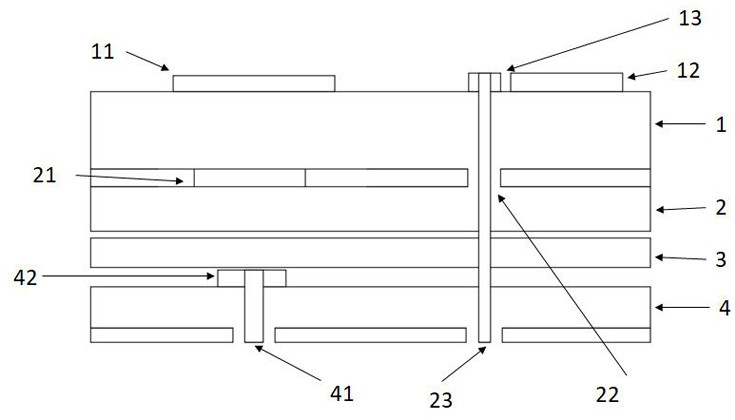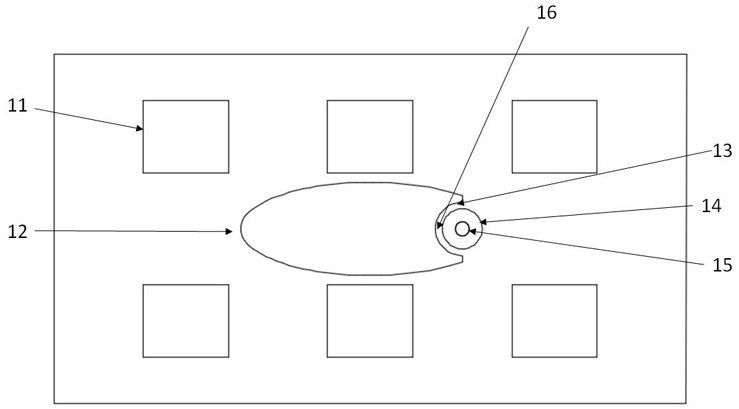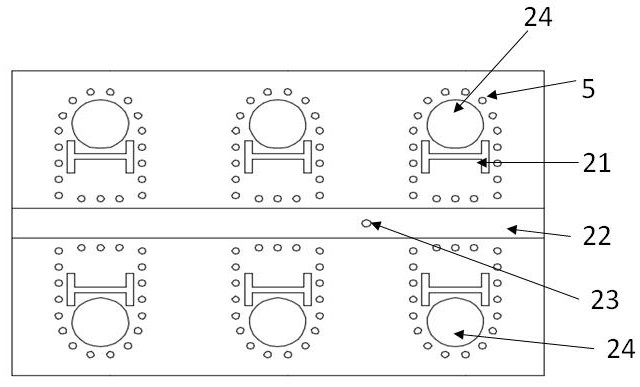Multimode Composite Antenna
A compound antenna and antenna technology, which is applied in the directions of antenna, antenna coupling, antenna array, etc., can solve the problem of too large antenna array, achieve the effect of simple antenna structure, improve aperture utilization, and solve the effect of too large array
- Summary
- Abstract
- Description
- Claims
- Application Information
AI Technical Summary
Problems solved by technology
Method used
Image
Examples
Embodiment 1
[0044] Such as figure 1 , figure 2 As shown, the multi-mode composite antenna includes an A-band antenna and a B-band antenna,
[0045] A-band antenna includes four dielectric layers 1-4, A-band radiation patch 11, heterolayer coupling slot 21, shielding hole 5, feed avoidance slot 22, welding hole 24, shielding hole 5, feeder 42, A-band feed Port 41, A-band feeding ground hole 43;
[0046] The B-band antenna includes four dielectric layers 1-4, the B-band radiation patch 12, the same-layer coupling slot 13, the B-band feed pad 14, the feed hole 15, the feed avoidance slot 22, and the B-band feed port 23;
[0047] One of the polarization types of the two antennas is vertical polarization, and the other is horizontal polarization. By rotating the feeding direction of one of the antennas, the polarization type of its antenna is changed.
[0048] The A-band antenna is a hetero-layer slot-coupling antenna. The radiation patch and the slot are on different layers. The slot-coupli...
Embodiment 2
[0062] Such as Figure 9 As shown, the difference between the present embodiment and the first embodiment is that: the feeding avoidance slot 22 runs through the second dielectric layer 2 longitudinally, and the longitudinal direction is the width direction of the dielectric layer.
[0063] The A-band antenna adopts a different-layer slot coupling antenna. The signal enters the feeder through the insulator, and the slot is coupled to the A-band radiation patch. The B-band antenna uses an insulator to directly feed power to the pad, and is coupled to the B-band radiation patch through the same layer slot. The polarization types of the two antennas are the same linear polarization type. The antenna can be formed into an array antenna. Compared with the traditional phased array antenna, the phased array area is reduced. Compared with Embodiment 1, the difference lies in that the polarization types of the two antennas are the same.
Embodiment 3
[0065] Such as Figure 10 As shown, the difference between this embodiment and Embodiment 1 is that the interlayer coupling gap 21 is in the shape of a spindle. The middle of the spindle body is a horizontal straight segment, and the two ends include two spindle heads.
[0066] In some specific scenarios of high-frequency use, the aperture of the welding hole in the A-band antenna is subject to the processing technology. For the high-frequency antenna, the aperture ratio of the welding hole is relatively large. If the hetero-layer coupling gap 21 of the specific embodiment 1 is used , the hetero-layer coupling gap 21 will interfere with the welding hole. can be used as Figure 10 The spindle-shaped hetero-layer coupling gap 21 shown can solve the problem of interference between the feeding gap and the welding hole during the processing of high-frequency antennas. The A-band antenna adopts a different-layer slot coupling antenna. The signal enters the feeder through the insu...
PUM
 Login to View More
Login to View More Abstract
Description
Claims
Application Information
 Login to View More
Login to View More - R&D
- Intellectual Property
- Life Sciences
- Materials
- Tech Scout
- Unparalleled Data Quality
- Higher Quality Content
- 60% Fewer Hallucinations
Browse by: Latest US Patents, China's latest patents, Technical Efficacy Thesaurus, Application Domain, Technology Topic, Popular Technical Reports.
© 2025 PatSnap. All rights reserved.Legal|Privacy policy|Modern Slavery Act Transparency Statement|Sitemap|About US| Contact US: help@patsnap.com



